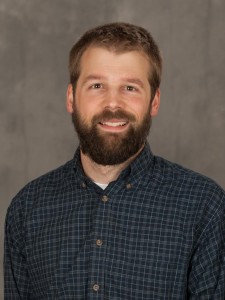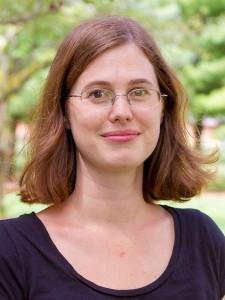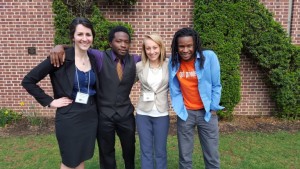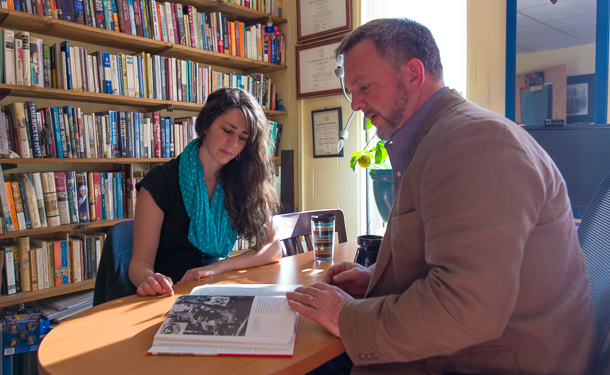Today’s students are “astute cultural historians who have been bombarded with media all of their lives,” says Eastern Mennonite University history professor Mark Sawin. “They’re immersed in film and music already, so when you talk seriously about film and music and provide a new toolset of analytic skills as a way of understanding culture, they get excited.”
In Sawin’s African-American history class, students investigate how African-American music and film impact larger American culture. This exploration raises other intersections of privilege, class, economics and politics.
“How, for example, can Louis Armstrong be the most popular performer in America at the same time that the KKK is winning elections in the South and promoting a racist agenda?” Sawin says. “And then later, we look at Blaxploitation films of the ‘70s. What does the financial and artistic success of these films, which simultaneously celebrate African-American culture but reinforce stereotypes at the same time, tell us about what is going on in the country at the time?”
Sawin, who has taught at EMU since 2001, shares a contagious enthusiasm for American history that has spurred his undergraduate students and EMU history program graduates to their own academic successes in the field. Last spring, then-junior Elisabeth Wilder linked conservative activist Phyllis Schlafly with today’s battle for transgender rights in an essay that won the Francis J. Ryan Undergraduate American Studies Paper Award at the Eastern American Studies Association annual conference.
Two alumni, Holly Scott ‘02 and Peter Lehman ‘09, were encouraged to pursue doctoral work in the field. Scott, a professor and graduate writing tutor at EMU who recently completed her first book on US protest movements, earned a master’s degree in American studies at Penn State and a PhD in history at American University in American Studies. Lehman teaches at Hesston College in Kansas while completing his doctorate in American studies at Penn State.
“The way that Dr. Sawin can inspire students to produce conference-quality original scholarship on American cultural topics is a great asset to our history program at EMU,” says department chair Mary Sprunger.

She adds that the interdisciplinary approach to history is present in other courses as well, and that students are encouraged to gain a global perspective, offered through area studies courses, such as the history of Africa, Latin America, the Middle East and Asia. Sprunger, who has taught at EMU for 24 years, says she introduced a world history survey course to curriculum offerings “because I think it is important for us as global citizens to have some idea of what has shaped the international context we inhabit.”
‘What makes America America?’
While EMU doesn’t have a formal American studies program, Sawin teaches all his courses with the kind of creative, interdisciplinary approach that is the hallmark of the field. Both the field and the interdisciplinary approach has gained popularity around the world: next spring, Sawin will return to teach an American studies course at the University of Zagreb, Croatia, where he taught classes on US culture, literature and religion as a Fulbright Scholar in 2008-09.
A quick history lesson: The field of American studies developed during the Cold War, when the United States government wanted more academics exploring, studying and generally praising American culture and history to “reinforce America’s superiority to the Soviets.”
“The question American studies perpetually asks is, ‘What makes America American?’” Sawin says.
By the early 1950s, most schools had responded to this initiative with at least one class on American history viewed through the lens of culture. Programs soon morphed into anything but a conservative, patriotic agenda.
“Any time the federal government tries to do something with academics, it backfires,” Sawin says with a laugh. “It became left-leaning and socially active pretty quickly.”
Holly Scott’s area of specialization is social change movements: she is publishing her first book—Younger Than That Now: The Politics of Age in the 1960s—in June. She says her experience learning about and working in social justice issues as an undergraduate student at EMU was a prime influence in her focus.
“Seeing their passion for their subject matters,” says Scott, who praises EMU history professors for challenging her intellectually. “Enjoying the

world of ideas definitely put the idea of graduate study in my mind. I went to a large high school and never really saw myself as someone who might go into academic work. I think without the small classes and individual attention at EMU, I probably never would have gone on to graduate school.”
Scott says she came to EMU from a home where “lively political discussions” flourished. “And my dad has a great collection of 1960s record albums. As I dived deeper into the records, I started to see the connections between music, culture and politics—a combination that fits well in the American Studies world.”
That kind of cultural engagement is an experience that current students bring with them into the EMU history classes, Sawin says. “Often, their experience with high school history is thin, mostly politics and economics with a little social culture. So when we look at film, music and literature, and when we take the religious, scientific and social movements of the country seriously, it helps create a more complete picture of America.”
Research inspires careers

Opportunities for independent research projects, often with an ethnographic slant, encourage students to look critically at the world and culture they live in. This spring, four students who had written research papers in Sawin’s “History of Recent America” class were invited to present at the American Studies Association’s Eastern Region conference (Sawin has served on the region’s executive committee since 2003, including two years as president and EMU hosted the regional conference in 2013).
Peter Lehman took two courses with Sawin—“Reading 19th Century America” and “The History We Tell Ourselves,” which prompted the pursuit of American studies in his graduate work.
“I was interested in the histories of many different regions, but often felt like as Americans, we have the extra responsibility to have a clear-eyed view of our own history. It so greatly affects our self-perceptions,” Lehman says. “I have always enjoyed literature, as well, so American studies seemed like a great way to combine those two fields in a useful way.”
His time at EMU, he added, also brought a faith lens and “sense of mission” to his studies.
“It can be interesting and fun studying U.S. culture,” he says, “but we as Christians must also understand where we should fit, how we can serve others, resist and otherwise relate to culture, while remaining sensitive to the impact of our own actions, narratives and traditions.”
Sawin hopes painting the tapestry of history with broad brushstrokes continues to inspire new learners.
“Students like having things made relevant, and cultural pieces are ones they resonate well with,” Sawin says. “You see how people lived day to day. It takes a lot of different methodologies from different disciplines to help people best understand.”
